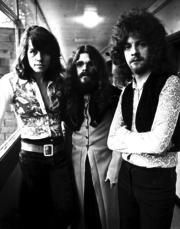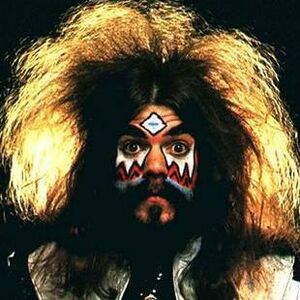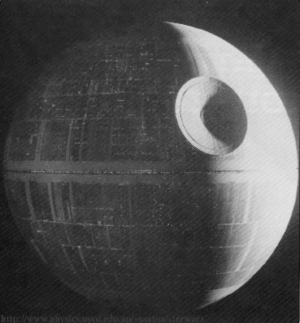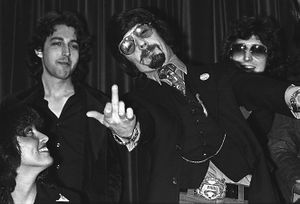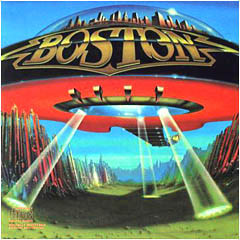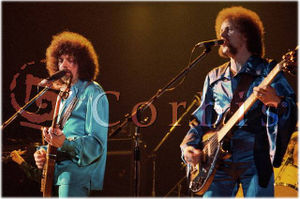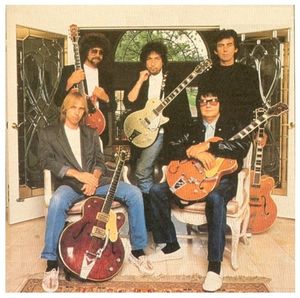ELO
“Who?”
Excessive Lynne Orchestrations (ELO) is a hugely successful British progressive pop-rock group. Fronted by reclusive facial hair enthusiast and shower gel guru Jeff Lynne Otis Wilbury and managed by notorious mafia boss Don Hardonn, they placed no less than 54,678,002 singles on the US and UK pop charts from 1972 to 1986, yet are essentially unknown to the general public today.
Fortunately for Otis, the few people who do remember ELO all work in the advertising industry, with the result that their songs appear in several dozen television commercials and movie trailers every year. The royalty income this produces for Wilbury allows him to champion the careers of up-and-coming unknowns like Paul McCartney and Tom Petty by overproducing their albums.
History
1965–1969: The Mauve
ELO began as a side project of The Mauve, a mid-to-late 1960s British pop group fronted by Roy "Morning" Wood and featuring drummer Bebe "Butch" Buell. A series of controversial publicity stunts such as eating automobiles one piece at a time and assassinating the British Prime Minister pushed singles such as "The Ceiling is Melting (Despite Me Drug-free Lifestyle)", "Penny Fields Forever", and "Do Me" to the top of UK charts. Unfortunately, nobody in America ever heard of them except Todd Rundgren, Cheap Trick, and three music critics (none of whom were named Lester Bangs). Their 1968 meetup, unofficially dubbed the "Ultimate Mauve Fanclub Bonanza", took place in a rented bouncy castle, which comfortably accommodated all eight (count 'em!) attendees.
When The Mauve's front man Carl Vain tried to move the band in the direction of contemporary Christian musical theatre, he was unceremoniously replaced with Jeff Lynne, a fuzzy-haired chap with a goatee who had fronted an unsuccessful white power pop group called The Master Race. Lynne joined The Mauve only with the understanding that they would form a side-project called "ELO", jump on any offers they received to make music for roller disco exploitation films, and never, ever photograph Lynne with his sunglasses off. Jeff, Roy, and Bebe then recorded the last Mauve album, Freedom from the Contract, and prepared for the next step.
1970–1973: The Obscure Years
Here the chronology grows a little fuzzy, because tracks for the first ELO album were recorded during the same period (and sometimes during the very same studio sessions) as The Mauve albums Lookie Here and Freedom from the Contract, the Roy "Morning" Wood solo album Over the Shoulder Boulder Holder, Bebe's solo album More Songs About Football and Gay Men and, of course, Chinese Democracy.
Lynne and Wood used the same methodology to produce the first ELO album that they had perfected on the last two Mauve albums: Basic tracks were recorded, then a second basic track was overdubbed on top of the original basic track, then Roy would overdub cellos, a ten minute sitar solo, a bagpipe arpeggio and about fifty billion oboes. Finally, they would wipe away both the basic tracks and overdub even more goddamn oboes. When it was decided that something more was needed in the mix to offset all those fucking oboes, they hired Steve "Wooly" Woolam to play violin and, subsequently, gave him a glowing reference for a sheep-shearing job.
The album band's debut album was released in 1971, creatively titled The Electric Light Orchestra in the UK and, due to a misunderstood phone message, No Answer in the US. "Dear Prudence Overture" was released as a single and, tragically, resulted in Jeff Lynne appearing on Top of the Pops dressed as a gay pirate.
During the recording of their second album, ELO 2: Electric Light Boogaloo, Roy "Morning" Wood was ousted from the band by drummer Bebe Buell, who claimed that "The Riot of Stonewall Moor" was irrefutable proof of Wood's second life as a transvestite prostitute at medieval fairs and felt threatened by Roy "always checking out [his] junk".
1973's ELO 2 featured an almost entirely new lineup, given that Roy Wood was no longer available to play virtually every featured instrument. The most notable of these was keyboardist Richard Radioshack, soon to become Lynne's right-hand man and, by extension, the only other member of the band he allowed to contribute anything creatively beyond playing his respective instrument and listen to his extended drug-fuelled monologues on his favorite topics (most prominently shower gel and whether Paul was dead). In a nod to the "boring rock" movement then in fashion, ELO 2 consisted of only five excruciatingly long songs, including "Jeff's Boogaloo #1", "Jeff's Boogaloo #2: Boogaloo Boogaloo" and the perky, light-hearted anti-war song "Kia" (which would later be used as the soundtrack to a GMC commercial). The big hit, though, was their cover of Chuck Berry's "Rock (& Roll) Me Amadeus" (later covered again by Mr. Radio Head).
1973's On the Third Day, which was, in fact, recorded on a second day, featured a return to short, radio-friendly songs, which were then linked together in suites with tuneless interludes to please the "boring rock" devotees. "Slow Down", a soul-influenced song that Jeff Lynne originally wrote for a premature ejaculation PSA, became a hit and was warmly endorsed by a heavily drugged John Lennon. Unfortunately, the album was poorly distributed in America due to a cover that featured all seven members of ELO exposing their assholes.
1974–1978: The Ubiquitous Years
Lynne first used a full orchestra (as opposed to an orchestra who had not yet eaten dinner) on 1974's Eldorado, a concept album about two swindlers named Tulio and Miguel who are on a wacky quest to find the titular legendary city of gold in the New World. It spawned not one but two US hits, "Boy Blew (Hey, He Needed the Money)" and "I Wish I Could Get This Damn Song Out of My Head". Seeking a more grandiose, world-conquering aesthetic for his music's orchestrations, Lynne hired orchestral arranger and perennial avenger of justice Lois Clark Kent, who agreed to henceforth take time out of maintaining truth and justice across Metropolis to embellish a B-list rock band's albums with an even greater quantity of string overdubs. Somewhere, thousands of miles away, Lex Luthor cackled with sadistic glee at this development.

Unfortunately, the experience of working with a British orchestra was disheartening, as their collective flatulence rendered dozens of takes (and the studio itself) unusable. Lynne would subsequently flee to Germany, where he would create his most commercially successful work under the watchful eye of legendary one-named engineer Madonna. Also around this time cellist Pike Edwards left the group and set up a Bhudist grapefruit and hay bale farm, cruelly brought to an end when a runaway Ford Transit van came tumbling over a hedge and smashed in to Edwards whilst out gathering hay!
Shortly after recruiting midget bass player Kelly Groucutt, whose undistinguished stylings would take the band well into the 1980s, ELO decamped to Arbeit Macht Frei Studios to record 1975's Faceless Music. Hits like "Evil Woman" and "Estranged Magic" took the album into mega-platinum territory, while controversy erupted over so-called "secret messages" (opening track "Fire on High" featured a backwards recording of drummer Bebe Buell saying, "Oi! Yer all a bunch o' bleedin' poofs").
Expectations (and listeners) were high for the follow-up, 1976's A New World Record. The album cover sported the landmark public debut of the ELO Mothership, a state-of-the-art spacecraft designed to capitalize on Lynne's rising stardom and made a reality by Lois Clark Kent's winning combination of heat vision, super strength and engineering know-how. Bebe Buell, the band's contemporary spokesperson, touted the craft as containing a functioning warp drive, sufficient laser power to incinerate an entire planet and aesthetics so flamboyantly and impossibly '70s in nature that the mere presence of the craft could instantly perm hair and cause any building within a five-mile radius to uncontrollably metamorphose into a roller disco. Radio, meanwhile, was saturated with Jeff Lynne compositions like "Telephone Lynne" (five minutes of a bullhorn feeding back), "Livin' Thing" (long rumoured to be a protest against stem cell research), and "Rockaria!" (decried by critics as "something quite atrocious"). In an unexpected turn of events, The Mauve's final hit, "Do Me", was reworked, the guitar–bass–drums minimalism of the original replaced with a full orchestra and choir, a legion of bagpipers, and the chanting of Tibetan monks. Believe it or not, that became a hit, too.
The commercial and artistic zenith of ELO's career was 1977's Out of the Blue, a double album lavishly packaged with a poster, full lyrics, a die-cut model of the Mothership, a roach clip, a lunchbox, Silly String, an Afro pick, and a Jeff Lynne Pez dispenser. The cover, with its ominous portrait of the Mothership hovering over the Earth, influenced filmmakers like George Lucas and Steven Spielberg to make movies about, like, space and stuff. The musical contents were no less spectacular: "Turning Stoned", "Street Walkin' Woman", and the bleak, relentless death march of "Mr. Blue Sky" occupied all positions on the Billboard charts that weren't already taken by the Bee Gees.
ELO toured relentlessly through 1977 and 1978, aided by the Mothership's faster-than-light travel. In fact, the bandmembers never actually left the Mothership; they just beamed their performances down to selected cities. Eventually they just started miming to studio recordings, but dropped the miming when they realised they couldn't be seen anyway. Critics called these concerts "impersonal and anonymous" and started raving about The Velvet Underground.
But Jeff Lynne was not yet content. He wanted to dominate the charts without any competition from the Bee Gees. To this end, he convinced the brothers Gibb to star in Sgt. Pepper's Lonely Hearts Club Band (the movie) and retooled ELO for disco. Oh shit.
1979–1980: The Disco Years
Recorded under the working title Blondes Have More Fun on Shakedown Street than a Dynasty of Some Girls, 1979's Tubthumpery found ELO exploring synthesizer-heavy dance beats (just like the Bee Gees), sappy ballads (just like the Bee Gees) and falsetto harmonies higher than a glue-sniffer in a hot-air balloon (just like Frankie Valli and the Four Seasons). Hits included "Smell a Little Glove", "The Diary of a Morose Chimp", and "Won't You Go Down, Bruce". That last song was recorded at the last moment when it was helpfully pointed out that everything else on the album sucked. This ultimately established the tradition of placing some tired old rockabilly retread at the end of every subsequent ELO album (to be extracted as a single, natch).
ELO recorded a music video of the entire Tubthumpery album, in which the entire band wore satin shirts, pranced about in front of rainbows, and, during "Man Train to London", fellated The Village People. Drummer Bebe Buell, who appeared in the video with a terrible perm, a flowing velvet robe and a foot-long cigarette holder, would punch anybody who so much as mentioned it in the '80s and '90s. Following the recording of the music video, an inebriated Lynne packaged both the band's longtime cellists (themselves rendered unconscious for similar reasons) into a crate and shipped them to Stravinsky National Park, a reserve in Outer Mongolia in which string players could run free and play their instruments in an environment untouched by synthesizers. Immediately afterwards, Lynne revealed that he and Richard Radioshack had purchased the Yamaha CS-10538, a "dream machine" of a synthesizer which contained high-fidelity emulations of ELO's signature acoustic string sounds, multiple onboard effects, three retractable cupholders, five cigarette lighters, an entire portable shower system to ensure players' hygiene during late-night studio overtime and a free stick of gum. To conserve electricity (given the considerable power needed to run these features), the unit was instead fuelled by dope, pretty much exactly like the cello players it had replaced. The "Dream Machine" would subsequently provide 95% of the "orchestrations" on ELO's subsequent albums, rendering a third of the band's name a pointless artifact.
In 1980, the cut-down ELO were asked to contribute half the soundtrack of Xanadu, a roller-disco-fantasy-Western-sci-fi-snuff-porn film starring Olivia Newton John as Geddy Lee and Gene Kelly as Samuel Taylor Coleridge. Lynne foolishly rejected the offer and, of course, Xanadu went on to break box office records, sweep the Oscars, and regularly top Entertainment Weekly "bestest movie of all time forever and ever" polls, beating out even such perennial critical darlings as Troll 2 and Doogal (which nonetheless usually ranked second and third respectively behind Xanadu). Most ELO fans believe this caused Lynne to sink into a deep depression and "phone in" the next three albums.
1981 - 1986: The Other Obscure Years
1981's Thyme was a lot like Eldorado, except that this time around, the swindlers were a time machine, the lost city was the future, and the orchestra was Gary Numan. Hits included "Gro-Light", "Yours Truly in the Year 2525" and "That Song David Bowie Danced To In Those 'Coffee Achievers' Commercials (Why Didn't They Just Use A David Bowie Song Or, Conversely, Show Jeff Lynne Dancing?)" (Tired Old Rockabilly Retread #2). Another controversy erupted when it was rumoured that teenagers were getting high from smoking the notoriously dangerous herb thyme in honour of the album, but it turned out that teenagers weren't even listening to ELO anymore and what they were smoking was just harmless marijuana.
Meanwhile, Kelly Groucutt - his once-substantial role in the band's live shows reduced to understated bass-playing and occasionally falsetto-yelling "sasquatch!" in response to Lynne - decided that the time had come to break out from under Lynne's shadow with a more intellectual work. He quietly poached Bebe, longtime keyboardist Richard Radioshack, string arranger Lois Clark Kent (who was resultantly forced to postpone a vital meeting with the Justice League over the state of the Cold War, partially leading to the 1982 invasion of Afghanistan) and the band's on-off violinist, both to musically enrich his album and because they too were getting sick of Lynne continuously smoking thyme and rambling about shower gel in the studio while refusing to let them smoke different drugs or, for that matter, play anything. Kelly's resulting album, the ambitious Frankenstein-themed concept album Kelly Groucutt Presents Horace Wimp: The Modern Prometheus, was promoted 24/7 on MTV with a stream of music videos featuring Bebe reading out the album's lyrics in a creepy bullfrog baritone while Kelly sat straight-faced on a public bus driving repeatedly around a cul-de-sac in the background. When asked about this bizarre artistic decision, Kelly replied 'it's a representation of the modern man's malaise, it is, mate'. Unfortunately, Lynne caught wind of the album and - after watching one of its music video while sky-high on thyme - began to believe that Horace Wimp was a spiritual epithet of his who would steal his soul "like that Dorian Gray bloke" if the album rose above #47 on the Billboard album chart. Now a man with a mission, Lynne set out to sabotage the album's release and succeeded, jamming empty bottles of ELO-branded shower gel into pressing plant machinery to stall production and employing a pair of FBI secret agents (aliases Mulder and Scully) to hunt down Kelly on grounds of 'roight well 'arnessing 'is supernatural powers to knock me off'. Kelly subsequently went on the run, while Lynne regrouped his remaining bandmates.
Jeff Lynne had always enjoyed writing in exotic locales, and this time around he decided to give Bangkok a try, bringing along Radioshack, a reluctant Bebe and the shady Sweeney Todd-esque guitarist Dave Organ (allegedly to 'give the songs some more meat', an apt description in more ways than one) for the ride, by which we mean that Lynne did virtually everything and occasionally asked Radioshack to hand him his backscratcher to create the illusion of a band effort. The resulting album, 1983's Secret Massages, was originally conceived as a double album (because it would fulfill ELO's contractual obligations) but was distilled down to a single disc (because nobody gave a shit about ELO anymore). A despondent Jeff picked out the best songs and placed some of them on b-sides while saving the rest for future box sets. The remaining tracks (including Tired Old Rockabilly Retread #3, "Rocky Road is Keen" (working title "Chuck Berry Ripple Factory"), a Chuck Berry-esque ode to Lynne's favorite ice cream flavor) were rerecorded in a minimalistic style at Lynne's house and released as a single disc in 1983. Oh yeah, and if you bought the cassette or CD, you got a bonus track, but it was just another dumb song about smoking thyme.
At this point, Lynne was fed up – and who wouldn't be! It was now the 1980s, and music seriously sucked ass. Lynne, pop genius that he was, came up with a post-modern masterpiece of an idea: He would record a parody of 80s music so hideously over-the-top and tasteless that nobody could possibly take those production techniques seriously afterward. To that end, he used electronic drums, a Yamaha DX-7, samples, digital reverb, and a "saxophone". I mean that really, really annoying 80s saxophone. You know the kind I'm talking about – it always sounds a lot like "Old Time Rock and Roll" by Bob Seger and makes you want to hit yourself in the forehead with the pointy end of a claw hammer. Yeah, that one.
But Jeff did his job too well. Neither critics nor fans nor the larger mainstream audience understood the satirical nature of ELO's last original album, 1986's Fulfilment of Contract. All they heard was a seriously shitty album (let's be honest here, no shittier than just about anything else from that time). Jeff Lynne's desperate warning was ignored, and the world was conquered by Starship's Knee Deep in Your Hoo-Ha, a competing parody of synth-laden '80s kitsch perhaps not-too-coincidentally also masterminded by the ashes of a '70s rock band. With the final strains of "Bend It" (Tired Old Rockabilly Retread #4), ELO was no more.
Interim and solo projects
McCello
Meanwhile, thousands of miles away from Lynne's career suicide, the two cellists he had relocated in 1979 roamed contentedly in Stravinsky National Park, sawing their instruments proficiently and performing goofy acrobatics in the midst of the vast central Asian steppe, much as they had done onstage a decade earlier. A crisis struck in 1989, however, when the Fat Dope-Smoking Cellist (having finally depleted his vast pocketed supply of the drug) recognized that the sole chance of restocking his stash with no money on his person lay in finding his emergency rations at home and, ergo, in returning to the UK. Parting ways with the Other Cellist (who inhabits the reserve to this day), he promptly hitchhiked to Beijing and hid in a shipment truck headed to Hong Kong, hoping to reach London via cargo freighter. Unfortunately, he was thrown off the freighter almost immediately due to a ship hand's dislike of his beard and desperate, instead decided to float across the Pacific manually on his cello. This somehow worked successfully enough that he washed up alive (albeit coated in seaweed and with multiple octopi and jellyfish having infested his waterlogged cello) on the Californian coastline four months later.
The cruel hand of misfortune would strike again, however, when a jogging David Hasselhoff caught sight of the freshly-beached cellist and, impressed by the musculature the man had amassed from years of (unknowingly to him) performing acrobatics around the Mongolian steppe and manually paddling across a whole ocean, was immediately stricken by the mortal and petrifying primal fear that this kelp-smothered newcomer would jeopardize his newfound monopoly on ripped lifeguard acting parts. Instantly whipping out his brick-sized cellular phone, Hasselhoff rang the Natural History Museum in London to alert them to a new specimen they could capture and exhibit to the gullible British public, thusly ensuring that this challenger would be dumped as far from California (and the Hoff) as humanly possible. The Museum, ecstatic at the discovery of this "weird-ass merman thing" (as eloquently put by one of its top scientists), promptly sent a squadron of their best and brightest to overpower the nearly-unconscious cellist and shove him into a cardboard box for transatlantic shipment. The Cellist was subsequently placed on display behind glass in London, where he - in a convenient twist of fate - re-encountered his former ELO bandmate the Violinist only a few weeks after arrival. Already weary of the rigours of standing still in front of an audience rather than dancing and somersaulting thereof, the Cellist reminisced about the elaborate gigs and eye-melting fashions of the 1970s with his old friend, inspiring him to re-enter the music scene with his assistance. The Cellist's abduction had also coincidentally brought him to the doorstep of his beloved dope supply, rendering the possibility of escaping a double win. With nothing left to lose, the string player used his cello's spike to saw through the exhibit glass that same night and promptly escaped the museum to found a new band, "McCello", with him. The group scored one hit - "Croc Dance", an instrumental ode to the Violinist's favourite footwear brand which rocketed to no. 98 on the Lichtenstein music charts - and sold a whopping 37 records.
ELO Part Deux and Excessive
Meanwhile, drummer Bebe Buell found himself in a bind. With ELO having been unceremoniously abandoned by Lynne, he was running short on cash and found little steady employment to replace his formerly-lucrative occupation, as most music producers of the period (Jeff Lynne among them) had long replaced biological drummers with Oberheim DMXs. Some of the younger guard approached by Bebe, having even forgotten that drummers could be human, mistakenly identified him as an experimental cyborg featuring human tissues grafted around a DMX's CPU and spread the word around the entertainment industry. After deterring an overly eager James Cameron from examining his supposed "circuits" by sending Dave Organ after him, a frustrated Bebe finally realized that, as an equal shareholder in the ELO name, he could simply reform the band under a slightly modified name and prove to the world that the group's music was more than just Lynne's Excessive Orchestrations. Promptly, Bebe gathered together Lois Clark Kent, his role in the Justice League having diminished and left him with more free time as the Cold War fizzled out, and several talentless unknowns to form ELO Part Deux in 1989. As you'd expect from that lineup description, they were nearly as cool as post-John Fogerty Creedence Clearwater Revival and post-John Bonham Led Zeppelin.
Soon recognizing an urgent need for additional coolness (read: more original ELO alumni) for the band's live debut in 1991, however, Bebe contacted Don Hardonn (who still owed him a favor for his pivotal role in assassinating the British Prime Minister in 1968) and requested that he use his mooks to infiltrate the FOX TV network. Subsequently, Bebe travelled to central Africa and tracked down Kelly Groucutt, now living deep in Rwanda under the alias of the German missionary Klaus Handelbaar to conceal himself from Mulder and Scully, and recruited him for Part Deux on two conditions: that he lose the lederhosen on account of not being German, and that he lose the moustache on account of fashion sense having improved immeasurably since 1976. Weary from years of living off nothing but schnitzel and sauerkraut to maintain his cover, Kelly immediately tore off his lederhosen, shaved off his moustache and flew back to Birmingham now wearing only a fig leaf; this would become his signature stage persona for the rest of his life. Bebe then approached Mulder and Scully and offered them an ultimatum: continue their mission, or give up the gruelling, futile eight-year chase and accept starring roles in a FOX TV show "pitched" by Don Hardonn. On account of not being idiots, Mulder and Scully agreed to the latter, leaving Kelly a free man and ELO bandmate once again. After the failure of McCello, the Violinist and the Fat Dope-Smoking Cellist also returned to the fold, although the latter was literally kicked out of the band (and the stadium altogether) during a mid-show gymnastics performance by new member Pete Hikick only months later. As of 2025, he is still believed to be stuck in orbit, occupying his days by smoking dope for sustenance and playing his cello in the vacuum of space.
For the next ten years ELO Part Deux toured the globe playing cool versions of Jeff's songs, and they released new cool records as well: ELO Part Deux: Electric Light Beugaleux (1990) and Waste of Effort (1994; also known as Moment of Recording a New Disc Pretending to Be ELO), both of them critically acclaimed for the way they made ELO sound just like Asia. Part Deux was not to last, however, as Bebe fell victim to a freak teleportation beam splicing incident in 1999, the result of a legitimate extra-terrestrial spaceship's crew catching wind of the similarities between their craft and the ELO Mothership and attempting to beam Bebe onto deck to serve him with a lawsuit. With only Bebe's lower body remaining on Earth - and said lower body refusing to drum to the same goddamn ELO songs for the five thousandth time due to creative differences with the band - the remaining members of Part Deux were forced to part with him and regroup as Excessive, having lost the rights to use the 'Lynne' and 'Orchestrations' parts of the name with both Lynne and Bebe absent.
Joined by guitarist, expert javelin-thrower and half-blood Pantheon Orwell and foul-mouthed drummer Gordon Bennett in place of Bebe's lower body, Excessive continued to perform cool versions of Jeff Lynne's songs into the new millennium, even releasing the admittedly-not-too-bad album No Refund in 2001. Tragically, however, the band lost Kelly Groucutt in 2009 when - while staying in Norilsk following a local performance - he left the band's hotel to retrieve his fuzzy dice and was accidentally locked out in the cold. Wearing only his customary fig leaf, Kelly quickly succumbed to Norilsk's sub-zero winter temperature and was discovered by Gordon Bennett the following morning frozen in a block of ice. With even Lois Clark Kent's heat vision failing to revive him, Kelly's body was subsequently donated to a Russian government facility, where he continues to reside alongside the similarly-frozen forms of Scrat and various B-movie monsters.
With only two ELO alumni now remaining alongside four or five random guys, Excessive continued into the 2010s, playing successively less cool versions of Jeff Lynne's songs and releasing no new albums. Upon the death of Lois Clark Kent - the result of a freak kryptonite accident - in 2021, the band's management decided to replace most of its less-marketable members (read: everyone except the one remaining ELO member) with deranged aardvarks, which ate only ants (reducing food costs on tour) and only occasionally demanded better pay. This version of Excessive continues to tour into the present, playing avant-garde swing jazz, techno-dub reworkings of Miles Davis compositions and intricate gamelan duets intertwined with enough oboe solos to make Roy Wood sob like an infant. Oh, and cool versions of Jeff Lynne's songs as well. Bebe's lower body, meanwhile, enjoys a peaceful retirement autographing middle-aged fans' ELO records and playing the digeridoo.
ELPs (Excessive Lynne Productions)
After abandoning ELO in 1986, Lynne, who had already helmed the board for albums by Three Stooges producer Del "Lord" Shannon, rockabilly revivalist Dave "Edmund" Fitzgerald and Run DMC, wanted to break into production full-time. To this end, he broke into George Harrison's house and held the ex-Beatle at knifepoint until he agreed to cut an album. The resulting disc, 1987's Strych Nine, was critically acclaimed for the way it made George sound just like ELO.
Lynne was now traveling in rarefied circles, giving him much-needed access to other famous musicians he could hold at knifepoint and produce. Roy Orbison and Tom Petty alike surrendered to Jeff's blade and gated snare drum sound, and the resultant albums, The Diary of Mr. E. Blue Kingdom Radio Girl and Pull My Finger, were critically acclaimed for the way they made Roy and Tom sound just like ELO.
The Traveling Wilburys
In the late 1980s Harrison, Orbison and Petty held an intervention to stop Lynne's addiction to knifeplay. Thirty seconds into the intervention, Lynne – now calling himself "Otis Wilbury" – held all four at knifepoint until they agreed to form a laid-back supergroup of sorts called The Traveling Wilburys. The resultant albums, Greatest Hits (their debut) and Daed Si Yor (which sparked the "Roy is Dead" hoax), were critically acclaimed for the way they made all five of them sound just like ELO.
Bored one day in 1990, Wilbury held himself at knifepoint and recorded a solo album, Mystery Science Theatre. It consisted mostly of Otis playing snippets of really bad albums, then overdubbing humorously sarcastic and erudite comments with the help of two robotic sidekicks. The album was swiftly removed from shelves after a lawsuit from a Gizmonic Institute employee by the name of Joel Hodgson, but was critically acclaimed for the way it made Wilbury sound just like ELO.
Finding himself on the other end of his own knife was a shattering experience for Otis. "So that's what it's like," said Otis, "Quite frightening, actually." Wilbury vowed to never again wield a knife - even when slicing ham, instead requiring him to karate-chop the meat himself - and, incidentally, spent the next four years producing absolutely nobody.
The Threetles
1995 was the year that Otis - his personal life having reached an impasse after the depletion of his decades-worth supply of shower gel - decided to take pity on a struggling, obscure band from Liverpool called The Beatles, who were already gaining critical acclaim for sounding just like ELO. His production duties were made more challenging by the fact that one of the band's members, John Lennon, had been shot to death by an enraged Jesus Christ (in his terrestrial form, Mark David Chapman) way back in 1980. Emerging digital ouija board™ technologies made it possible for John to participate in the project, but it has to be admitted that Lennon's voice, aurally degraded by transmission from the astral plane, ended up sounding like a poor-quality cassette recording. Most of the resulting Apology series sounded like a bunch of outtakes that weren't intended for commercial release, but the two tracks Otis produced were critically acclaimed for the way they made The Beatles sound just like ELO.
Paul McCartney, suitably impressed by Wilbury's work with his old band and mindful of the fact that he might soon need that emerging technology to contact his wife Linda, asked Otis to produce a few tracks for his 1997 album 3.14159 on Fire. Although the results were critically acclaimed for the way they made McCartney sound just like ELO, Wilbury was growing restless. He was tired of producing albums that sound just like ELO and watching somebody else get the credit. The time had come again to produce an ELO album and make it sound just like ELO.
The Second History of ELO
2001: Don't Call It a Comeback (The Most Obscure Years)
So in 2001 - after wrangling the full rights to his band's name back from Bebe's lower body - Otis Wilbury recorded a solo album that sounded kind of like late-period ELO, in that it contained multiple tired old rockabilly retreads and copious use of the same damned gated snare drum. The album was stuffed with guest appearances by two ex-Beatles, George Harrison and Gringo Starfish, and of course his then-girlfriend Stevie Nicks who threatened to throw a major hissy fit and hex Otis if he wouldn't allow her to sing on it. Radioshack, an actual ELO member, only played on one track by comparison. Titled C'mon and Zoom, Zoom, Zoom-a-Zoom, it was marketed as an ELO "reunion" album and sold about 300 copies. Some have suggested that this sales figure was misquoted on release and that the latter two zeroes of this quantity are actually two decimal places. Needless to say, Otis was not pleased.
In a fit of pique, Otis obliterated 37 major American cities with the doomsday device installed on the upgraded ELO Mothership before Will Smith managed to infect the vessel with a computer virus that triggered its self-destruct sequence. Wilbury escaped and was holed up in his studio, sequencing box sets, dusting off unreleased tracks to put on reissues, and just generally plotting his revenge against a cruel, uncaring world.
2014–2023: Coming Back (for Realz)
In 2014 Otis made a comeback from the studio, much to the surprise of shocked peeps in the street, and announced that ELO was coming back, this time under the humble moniker of Jeff Lynne's ELO. This announcement triggered widespread panic; in London, every shop was closed and transportation systems were hectic, with citizens worrying that the ELO Mothership would decimate them again. In an interview, Otis confirmed that the album would be titled Ayyyy, We're Back Yet Again for Another Zoom-a-Zoom Adventure!; this uncreative title choice disappointed many fans and caused riots in Manchester, prompting Wilbury to do damage control and rename the album Alone in the Dark Universe.
So Otis recorded the album in Brum with his mates and presented it to the world in 2015. Then, he presented the single as if it were the Bible ... and it, the proud work we had been waiting for, was called "When I Was A Boy, I Was A Baby, An Annoying Tween, Then an Adult". The world cheered; all of a sudden London and Manchester came together and just rebuilt themselves again, but as a result Glasgow and Edinburgh collapsed, not to be seen again until a billion years had passed. The ensuing tour - featuring Otis playing alongside a series of no-name live sidemen and, on occasion, original ELO member Richard Radioshack - was a gargantuan success, so much so that the revenue cured world hunger and guaranteed Otis another millennium's worth of shower gel, thereby ensuring that he keep fresh into the foreseeable future.
Buoyed by his renewed success. Otis awoke one day in 2019 to discover that he had expelled an entire albums' worth of completed master recordings from his sinuses while sleeping, such was his creative inspiration. One track even somehow featured a guest appearance from Radioshack for reasons inexplicable to even the most powerful psychic. The resulting album, From Out of Them Nerves Between Me Nose and Me Brain spawned the hit single "One More Knife" - an allusion to Otis' recently-renewed passion for holding people at knifepoint - and resulted in another round of successful tours, themselves so successful that it was Liverpool and Sheffield's turn to spontaneously rebuild themselves. Owing to his contributions to urban development, Otis soon received an Order of the British Empire, which could be used to guarantee one free order of his choice at any restaurant. Seizing this once-in-a-lifetime opportunity, Otis promptly ordered a Big Mac and sat atop a sunlit hill overlooking the newly-reconstructed Liverpool while peacefully writing cease and desist orders to Excessive. Evidently, all was well in the ELO-verse.
2024-2025: The Final Chapter: Over and Under
In 2024, Otis announced his farewell tour, Over and Under, a homage to his signature movement when holding people at knifepoint. With Radioshack having passed away mere weeks earlier, Otis irrevocably became the sole original ELO member left in his band. Accompanied by the same crew of sidemen as before, he set out to complete the epic climax of his revived career: magically rebuild Los Angeles through the power of music. Although this was not fulfilled, Lynne was nonetheless content with the (much) lesser accolade of having reassembled Modesto within the span of one performance of "Won't You Go Down, Bruce".
It would not be long before disaster struck the tour, however. While performing in the UK in 2025, a backstage technician, abruptly summoned by Otis to sustain his freshness by handing him another bottle of shower gel between songs, accidentally left the ELO Mothership in overdrive. With no one at the helm to harness its almighty powers, the Mothership's engine erroneously entered warp mode, causing the vessel to accelerate past the speed of light. This subsequently drilled a wormhole in the space-time continuum through which the Mothership passed, destroying both the stage on which Otis was performing (to the shock and despair of thousands of Otis' loyal fans) and the nearby town of Wigan (to the shock and despair of pretty much no one). The wormhole subsequently closed, irrevocably exiling the Mothership from this star system. Climbing from the rubble of the stage, a thankfully-unharmed Otis, realizing that no amount of holding people at knifepoint could solve this particular quandary, decided to choose this moment to retire, concluding the "Over and Under" tour (and ELO altogether) prematurely.
The Mothership's fate, meanwhile, was only learned months later when a crew manning the James Webb Space Telescope, having finally decided to take a break from casually monitoring the strange dope-smoking cellist in orbit 24/7, logged that a lushly-vegetated planet with elements resembling a "kitschy '70s-styled flying saucer" had been observed orbiting a distant blue star. As this was the first time the planet had been detected in this system, the scientists operating the telescope concluded that the planet must have formed extremely recently, perhaps as late as six months earlier. In fact, the Mothership's weather simulator - long a source of inspiration to Otis in writing his endless parade of songs about rain - had also been left in overdrive by the hurried technician, forming a substantial atmosphere and climate system around the ship and fostering the rapid evolution of earthly dirt, bacteria, unsmoked thyme and algae clinging to the ship's surface into a complex ecosystem with a fully-functioning nutrient cycle, kept perpetually fresh by lurid blue oceans of life-giving shower gel. Further observations revealed that the planet was inhabited by a variety of animals closely resembling those on Earth - grown, unknowingly to the scientists, from DNA banks Otis had stored onboard the Mothership as a joke - who appeared to spend their lives in a continuous celebratory dance, exalting the great blue ship that fostered them. Subsequent radio signals received from the "planet" flashed out several soundwaves suggesting excessive string overdubs, seemingly emitted from deep within the "planet's" core, followed by a simple message on the observatory's data screens: chooka-chooka-hoo-la-ley. The legacy of ELO, it seemed, would live on across the universe.
Members
Enduring classic lineup
Although ELO has undergone many lineup changes over the decades, the core of the group during its most commercially successful period (1975–1979) consisted of:
- Jeff Lynne – the Main Dude, plus lead and backing vocals, guitar, bass, cello, keyboards, drums, percussion, sunglasses, producer, songwriter, composer, arranger ... Hell, everything on Zoom (1970–1986, 2000–2001, 2014–present)
- Bebe Buell – drums, percussion, bullfrog backing vocals, whale sounds, homophobia, "The guy who pretended to play drums" and "Tea Boy" in 1986 (1970–1986, member of Part Deux 1989-1999)
- Richard Radioshack – keyboards, Mellotron, vocoder, theremin, ostrich guitar, psychic piano, ARP 2500 Modular Polyphonic Syntesizing thingie, spiritual percussion, guitar when Otis had a hangover and couldn't be arsed (1972–1986, 2000–2001, 2014–2019)
- Kelly Groucutt – bass, girly falsetto vocals, four-string moustache (1974–1983, member of Part Deux 1991-1999, member of Excessive 2000 -2009)
During this period their string section consisted of three guys, plus Lois Clark Kent, who wasn't an official member but was important enough to the group's sound to pretty much qualify as one anyway:
- The Violinist Who Looks Kind of Like a Depressed Jeff Lynne But Without the Sunglasses – violin (1973–1979; 1981–1986, member of Part Deux 1991-1999, member of Excessive 2000-present, last Excessive member to not be a deranged aardvark)
- The Fat Dope-Smoking Cellist – cello (1972–1979, member of Part Deux 1991)
- The Other Cellist Who Looks Like a More Effeminate Richard Radioshack – cello (1975–1979)
- Lois Clark Kent – orchestral arrangements, synthesisers, live keyboards, defender of Metropolis (1974-1980, 1981-1983, 1986, member of Part Deux 1990-1999, member of Excessive 2000-2021, member of the Justice League until his death)
On account of most of this lineup's constituents being dead, accidentally spliced, roaming the Mongolian steppe, frozen in Russian government facilities, stuck in orbit or playing in a tribute band with African insectivores, it is generally considered unlikely that a full ELO reunion will ever see the light of day.
Other unimportant lineups
Currently Lynne Wilbury is the only remaining members of ELO, in addition to some no-name live sidemen. Radioshack was a member of the revived band for a while, but has now passed on. Other members from various points in the band's history include:
- Roy "Morning" Wood – the other Main Dude, plus lead and backing vocals, guitar, bass, cello, keyboards, drums, clarinet, bassoon, oboe, recorder, producer, songwriter, composer, arranger ... hell, nearly everything on The Electric Light Orchestra and ELO 2: Electric Light Boogaloo (1970–1972)
- Eric Clapton – ukulele (1970–1972)
- Alfred Vivalda – accordion (1970–1972)
- Steve "Wooly" Woolam – violin on first album, later took up sheep-shearing (1970–1971)
- The Dad of That Guy from The Wonder Stuff – keyboards, French horn, hunting horn (1970–1972)
- Michael D'Albacore – bass, harmony vocals, camel toe (1972–1974)
- Worf Gibson – violin on second album (1972–1973)
- Pike Edwards – cello; strings typically fingered with an orange or grapefruit (1972–1975)
- Andy Panda – cello (1972)
- Colin "Imperial" Walker – cello (1972–1973)
- Dave Organ – synthesisers, acoustic guitar, backing vocals, delicious meat pies of suspect origin (1981–1986)
- Kenny G – saxophone on Fulfillment of Contract (1986)
- Yamaha RY30 – drums on Fulfillment of Contract (1986)
Members of Part Deux and Excessive
Alongside Bebe, The Violinist, The Fat Dope-Smoking Cellist, Kelly Groucutt and Lois Clark Kent, various lifeforms have performed with ELO's spinoff groups:
- Eric Boyar - keyboards, lead and backing vocals, band vodka supplier, attempted assassin of Ivan the Terrible (1989 - 2021)
- Phil Gates - lead guitar and baritone lead vocals on Waste of Effort, twin brother of a certain Microsoft founder (1993 - 1999, 2007 - 2011)
- Pete Hikick - lead guitar, bass and lead vocals on ELO Part Deux, live gymnastics routines, man responsible for literally kicking the Fat Dope-Smoking Cellist out of the band during a live high jump (1989 - 1993)
- Flint Lockwood - lead guitar, keyboards and grunting Motley Crue-esque lead vocals on ELO Part Deux, later invented a machine that transforms precipitation into food (1989 - 1993)
- Pantheon Orwell - lead guitar and lead vocals on No Refund, designated band discus-thrower, token member of the Cult of Diosynsius (1999 - 2007, 2011 - 2021)
- Gordon Bennett - drums, live excessive profanity (2000 - 2021)
- Glen Beatnik - bass, lead vocals, band thyme supplier, creator of, like, deep poetry about alienation, man (2009 - 2021)
- Lois Clark Kent Jr - orchestral arrangements, cello, defender of Metropolis in his father's absence (2011 - 2021)
- Cliff Hillside - guitar, bass, lead vocals, band geography expert (2017 - 2021)
- Various deranged aardvarks (the entire band sans the Violinist since 2021)
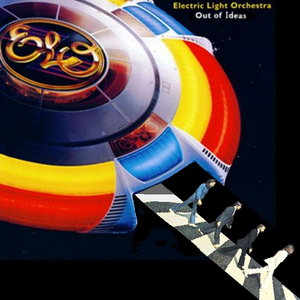
Discography
- 1971 LOL, it's ELO (UK), Who Gives a Shit (US)
- 1972 ELO Too: Electric Light Boogaloo
- 1973 On a Thursday
- 1974 The Night the Light Went Off (It Was A Long Night) – LIVE! (WG, AU, SA, ROTFL)
- 1974 Fleetwood Brougham
- 1975 Faceless Music
- 1976 Oh, Hey, it's ELO (compilation)
- 1976 A New Weird Record
- 1977 Out of Ideas (double album)
- 1979 Tubthumpery
- 1979 ELO's Greatest Shit (compilation)
- 1980 Three of Our Old Albums Packaged in One Box for Lots of Money (compilation)
- 1981 Thyme
- 1983 Secret Massages
- 1986 Fulfillment of Contract
- 1990 Afterbirth (box set)
- 2000 Asscrack (box set)
- 2001 C'mon and Zoom Zoom Zoom-A-Zoom
- 2015 Ayyyy, We're Back Yet Again For Another Zoom-A-Zoom Adventure!" (UK), LOL, It's ELO and you've been waiting for an album of this title to become available in the US ever since Uncyclopedia told you the UK version of that album was titled that (US)
- 2019 From Out of Them Nerves Between Me Nose and Me Brain


